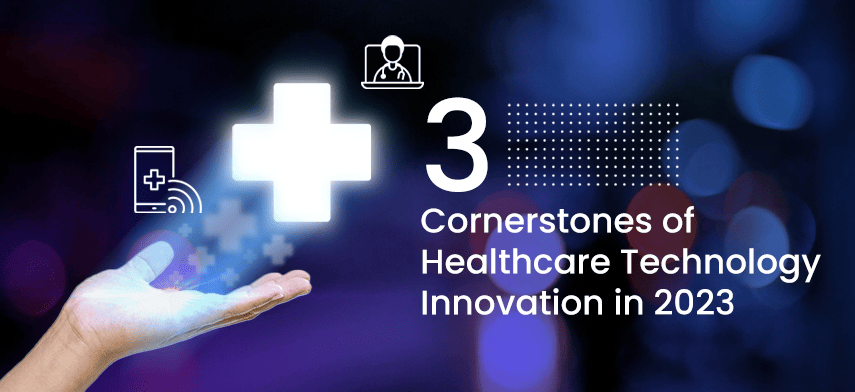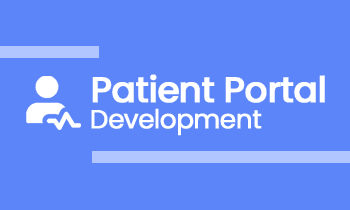As we constantly see emerging trends and technologies in healthcare, 2023 for healthcare technology innovation, shows promise toward increased decision-making complexities. This arises from the digital transformation and development of healthcare professionals.

When we look forward, various pathways are emerging to simplify any complex situation. With accurate coalescence, 2023 will see a poised clarity and reduced variability after the pandemic-fueled disruptions in the healthcare sectors.
Forging a space shortly in healthcare technology innovation will require high degrees of holistic approaches which have been simplified into three categories that will impact healthcare at the roots.
Emerging Healthcare Technologies Diversifying Clinical Innovation Beyond Hospitals
With the surge in current patient care technology, the clinical state of healthcare technology innovation will transform into a newer dynamic in 2023. This will create a buzz around diversifying clinical evolution. It can be said that looking into the upgrades in pharmacy, research, data collection, and telehealth are safely incorporated into the care delivery ecosystem.
Expansion with Pharmacy roles
Pharmacists have constantly played a critical role during the pandemic, as the public health emergency sector started educating and supporting patients. With patient care technology in the healthcare technology innovation sector, there’s the insurance of a streamlined supply of non-routine and stocked medicines for hospitals and the health sector. Pharmacists and pharmacy technicians also reserved the limelight during mass immunization combined with mindful health solutions and gained massive popularity and visibility at the point-of-care for specimen collection and testing purposes.Digital trends with the shift in the collision of healthcare, clinical pharmacists were able to use decision tools in bridging accessibility in care gaps. This further eliminated any haphazardness and improves care variability, better care coordination, and assures patients with a single source of evidence-oriented healthcare touchpoints. This shift will continue into 2023 with pharmaceutical practices and evolution in the public health emergency models.Telehealth in healthcare technology
More than a quarter-trillion dollar significance for technology in healthcare has been visible through telemedicine and telehealth implementation garnering maximum digital healthcare services attention. This attention has fueled the waves of new entrants and healthcare technology innovation. But the rightful integration of telehealth energy has to balance with the accuracy of clinical information gathered through evidence-based research (EBR). the increasing usage of telehealth and telemedicine as streamlined solutions has also raised questions regarding the quality of patient care results through digital health solutions and the underlying information gathered to address clinical-based decisions.The evidence-Based Telehealth Network Program discovered groundbreaking care accessibility through the efforts demonstrated through increased telehealth utilization. This helped in assessing telehealth care effectiveness for patients, payers, and providers with established and recognized evidence-based research. For private and public entities to continue their funds for telehealth research to gain more energy for EBR, targeting patient-oriented questions, using remote care teams, and the differences of telehealth offer to address issues vs. telehealth provided as a choice. Hence, it is recommended to continue comparisons with in-person patient care, especially for chronic conditions.Patient care technology improves communication and is more personalized
Providers utilize mindful health solutions to customize and improve inclusivity for education content for both patients in the physical and virtual environments. There’s a new wave in personalized digital healthcare solutions with emerging healthcare technologies that are supporting patients to navigate their health journeys and understand their health benefits. In 2023, the healthcare industry will see an abundance of outreach solutions that will be delivering tailored and inclusive educational materials in healthcare, reflecting diversity in patient care services.
Healthcare Technology Innovation Sculpting a Structuralized Patient Journey with Speciality in Medicine and Compliance
The result of mapping a patient’s journey is what healthcare technology innovation predefines in the medical context. In 2023, there will be a set expectation towards holistic and significant approaches to tackle emerging factors.
Data coding, interoperability, and facilitating accuracy in health data documentation
The pandemic was an impactful evolution in documenting patient journeys. This has left patients navigating through prevention methodologies, long-term impacts, and how prior the infection will intersect with pre-existing chronic conditions. The underlining value of collecting complete, clear, and precise health records emerged as a critically accurate reflection of the healthcare risk severity. This not only affected the mass but population health management, where the quality of metric reporting and its successes solely depend on value-based care bonding.This can begin with accurate documentation with the rise in CDI specialization. There is immense potential in closing these pressing gaps in the healthcare ecosystem. It can be observed that there is a certain chasm in the way providers document the patient care journey and how this information is translated into the ICD-10 codes for CMS and health plan companies. Centrally, the difference between clinical and coding logic comes to the forefront. With more shifts in care in the outpatient spaces, there will continue to be a reliance on clinical documentation/integrity (CDI) providers. Payoffs for CMS, health plans, and clinical practices will increase the proficiency of providers and improve patient care in a holistic approach.De-escalating drug and medicine prices with an increase in special medication management
It is anticipated that 2023 is a brighter year for the specialty medication management program. This will be possible due to the biosimilars and FDA-approved biologics taking the spotlight.Therequirement to understand clinical impact will increase dynamically. The next year will be increasing the demand for healthcare insights and healthcare technology innovation that will shed a light on specialty drug results. High-prescription medication made great headlines in 2022 and became a legislative action. Spending on prescription medication will continue to increase, thus, compelling an additional focus on safety, appropriateness, and cost-effectiveness utilization. Organizations in healthcare will see expected attention on specialty drugs and medication.Healthcare technology innovation improving patient safety and compliance
With the 2022 closing, the FDA will be issuing the final two guidances that will enhance patient safety via post-market surveillance and post-approval research and education. This will help the healthcare technology innovation industry to be more tightknit with the help of healthcare information technology oversight. Additionally, close monitoring for patient safety in medical devices will also cater to patient outcomes.Having the right compliances in a place like HIPAA, HL7 FHIR, and HITECH can ensure enterprises and startups implement intense regulatory environments. The healthcare industry can expect clinical leadership in building on-demand solutions and push back internal regulatory and legal teams for challenging the compliance strategy. It is detrimental to partner up with companies affluent in building and developing compliance to keep internal teams focused on offering the best services to patients.
Introducing Clinical Knowledge and Adapting Institutional Wisdom with Healthcare Technology Innovation
Witnessing the pandemic’s large-scale additional strain on the overstretched and burnt-out workforce, it is essential for healthcare organizations to have a streamlined clinical team. This clinical team further has access to recent evidence-based data and incorporated adequate support for delivering a well-thought-out patient care service.
Health care patient engagement with innovation in nursing and medical knowledge
A concerning digital trend in healthcare has been the surge in the retirements of nurses. Before the beginning of the COVID-19 pandemic, more than 62% of nurses over the age of 54 considered phasing out of their nursing careers. By 2022, a survey conducted showed 29% of Registered Nurses (RNs) in the US indicated retiring from their current allocated work in providing direct patient care. This is an extremely variable situation and most organizations in the healthcare sector will find it concerning to predict. This has resulted in losing a knowledgeable clinical workforce and nursing teams and facing challenges in healthcare staff shortage in supporting patient care services.There has been an expectation set where providers and clinical academic institutions pressed for experienced talents and workers are using healthcare technology innovation to scale the strapped resources. This has been done to reach a larger reader and learner base, promotion of competencies, and establish themselves by investing in digital development and transformation. To improve health care patient engagement, providers and nurses are exploring alternative care models of delivery to support access to patient care. Nursing teams will look forward to healthcare organizations embracing innovation in healthcare technology and competency-oriented holistic staff approaches. Hence, it will help them cater to concerns that are still occurring post-pandemic.Transformation in nursing teams through digital trends in healthcare training and education
For keeping up with constant drainage through long hours of work, most providers, nurses, and academic institutions will be finding themselves delivering deeper into the work of digital transformation. This helps in accessing new digital products and services that cater to improving professional education and training. Metaverse health will have a more practical role in building healthcare applications rather than on social media platforms, gaming, and many more.Virtual reality will create new, immersive, and in-depth learning opportunities to enhance engagement for students appearing for clinical education via practical skill practicing, working in diverse teams, and receiving exposure to complex and full case loafs managed y nurses in real life during real-time. This helps appearing nursing candidates prepare better for real-world challenges and practices in clinical practice, even without physical access to clinical settings. Having backup and support from virtual and augmented reality, human device interfaces, healthcare professionals, and administrators are using metaverse healthcare to improve and enhance nursing education and training.

What to Look for in Healthcare Technology Innovation in 2023?
The 2023 predictions align towards a more transformed and settled ecosystem for healthcare, even with disruptions from the COVID-19 pandemic. Healthcare big players and leaders will still face big challenges when it comes to regulation, affordability, and clinical staffing. But with the addition of healthcare technology innovation approaches, it can extend into clinical settings. Thus, keeping health care patient engagement at a higher level no matter their geographic location. Healthcare technology innovation will also explore newer staffing and engagement models where top leaders can move the needle by providing the best possible advice and outcomes. As we constantly see emerging trends and technologies in healthcare, 2023 for healthcare technology innovation, shows promise toward increased decision-making complexities. This arises from the digital transformation and development of healthcare professionals.
When we look forward, various pathways are emerging to simplify any complex situation. With accurate coalescence, 2023 will see a poised clarity and reduced variability after the pandemic-fuels disruptions in the healthcare sectors.
Forging a space shortly will require high degrees of holistic approaches which have been simplified into three categories that will impact healthcare at the roots.

Author's Bio

Shailendra Sinhasane (Shail) is the co-founder and CEO of Mobisoft Infotech. He has been focused on cloud solutions, mobile strategy, cross-platform development, IoT innovations and advising healthcare startups in building scalable products.


